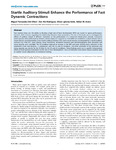Startle Auditory Stimuli Enhance the Performance of Fast Dynamic Contractions

Use este enlace para citar
http://hdl.handle.net/2183/41771
A non ser que se indique outra cousa, a licenza do ítem descríbese como Atribución 4.0 International
Coleccións
- Investigación (CCDEF) [299]
Metadatos
Mostrar o rexistro completo do ítemTítulo
Startle Auditory Stimuli Enhance the Performance of Fast Dynamic ContractionsData
2014-01-28Cita bibliográfica
Fernandez-Del-Olmo M, Rı´o-Rodrı´guez D, Iglesias-Soler E, Acero RM (2014) Startle Auditory Stimuli Enhance the Performance of Fast Dynamic Contractions. PLoS ONE 9(1): e87805. doi:10.1371/journal.pone.0087805
Resumo
[Abstract]: Fast reaction times and the ability to develop a high rate of force development (RFD) are crucial for sports performance.
However, little is known regarding the relationship between these parameters. The aim of this study was to investigate the
effects of auditory stimuli of different intensities on the performance of a concentric bench-press exercise. Concentric
bench-presses were performed by thirteen trained subjects in response to three different conditions: a visual stimulus (VS); a
visual stimulus accompanied by a non-startle auditory stimulus (AS); and a visual stimulus accompanied by a startle auditory
stimulus (SS). Peak RFD, peak velocity, onset movement, movement duration and electromyography from pectoralis and
tricep muscles were recorded. The SS condition induced an increase in the RFD and peak velocity and a reduction in the
movement onset and duration, in comparison with the VS and AS condition. The onset activation of the pectoralis and
tricep muscles was shorter for the SS than for the VS and AS conditions. These findings point out to specific enhancement
effects of loud auditory stimulation on the rate of force development. This is of relevance since startle stimuli could be used
to explore neural adaptations to resistance training.
Palabras chave
Auditory Stimuli
Performance
Fast Dynamic Contractions
Performance
Fast Dynamic Contractions
Descrición
This work was supported by Xunta de Galicia (CN2012/1702)
Versión do editor
Dereitos
Atribución 4.0 International
ISSN
1932-6203






